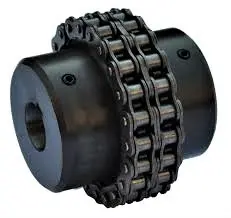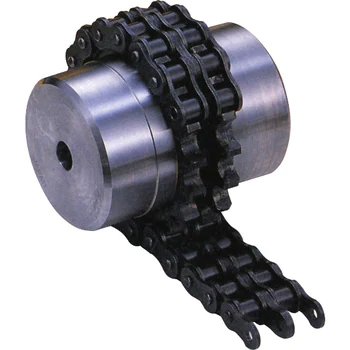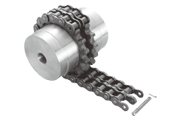Product Description
Flexible.
Compact size has powerful transmission capacity.
Metal-built.
Easy-mount-and-demount.
| MODEL NO. |
BORE DIA | D | DH | L | I | S | MAX. TORQUE |
WEIGHT | SHELL | |||
| MIN. | MAX. | A | B | WEIGHT | ||||||||
| mm | mm | mm | mm | mm | mm | mm | kN.m | kg | kg | |||
| CHC3812 | 9.50 | 16.00 | 45.00 | 25.00 | 64.90 | 30.00 | 4.90 | 0.249 | 0.3 | 61.00 | 57.00 | 0.1 |
| CHC4012 | 11.00 | 22.00 | 61.00 | 35.00 | 79.40 | 36.00 | 7.40 | 0.329 | 0.8 | 75.00 | 75.00 | 0.2 |
| CHC4016 | 15.00 | 30.00 | 77.00 | 50.00 | 79.40 | 36.00 | 7.40 | 0.419 | 1.4 | 92.00 | 75.00 | 0.3 |
| CHC5016 | 15.00 | 38.00 | 96.00 | 60.00 | 99.70 | 45.00 | 9.70 | 0.791 | 2.6 | 111.00 | 85.00 | 0.6 |
| CHC5018 | 19.00 | 45.00 | 106.00 | 70.00 | 99.70 | 45.00 | 9.70 | 0.979 | 3.5 | 123.00 | 85.00 | 0.8 |
| CHC6018 | 22.00 | 55.00 | 127.00 | 85.00 | 119.50 | 54.00 | 11.50 | 1.810 | 6.0 | 142.00 | 106.00 | 1.2 |
| CHC6571 | 25.00 | 75.00 | 151.00 | 110.00 | 119.50 | 54.00 | 11.50 | 2.610 | 9.5 | 167.00 | 106.00 | 1.6 |
| CHC8018 | 30.00 | 78.00 | 169.00 | 115.00 | 149.20 | 67.00 | 15.20 | 3.920 | 14.0 | 186.00 | 130.00 | 2.5 |
| CHC8571 | 35.00 | 95.00 | 202.00 | 140.00 | 146.20 | 67.00 | 15.20 | 5.640 | 20.0 | 220.00 | 130.00 | 2.7 |
| CHC1571 | 38.00 | 110.00 | 232.00 | 160.00 | 200.80 | 91.00 | 18.80 | 8.400 | 34.0 | 248.00 | 144.00 | 3.0 |
| CHC12018 | 48.00 | 120.00 | 254.00 | 170.00 | 260.80 | 119.00 | 22.80 | 12.700 | 50.0 | 309.00 | 185.00 | 7.2 |
| CHC12571 | 58.00 | 150.00 | 302.00 | 210.00 | 260.80 | 119.00 | 22.80 | 18.300 | 65.0 | 357.00 | 185.00 | 9.0 |
| CHC16018 | 68.00 | 160.00 | 341.00 | 220.00 | 360.10 | 165.00 | 30.10 | 26.400 | 122.0 | 402.00 | 240.00 | 9.6 |
| CHC16571 | 78.00 | 200.00 | 405.00 | 280.00 | 360.10 | 165.00 | 30.10 | 38.100 | 185.0 | 466.00 | 240.00 | 16.3 |
| CHC20018 | 88.00 | 205.00 | 424.00 | 295.00 | 519.60 | 241.00 | 37.60 | 54.100 | 288.0 | 490.00 | 270.00 | 19.0 |
| CHC20571 | 98.00 | 260.00 | 505.00 | 375.00 | 519.60 | 241.00 | 37.60 | 77.800 | 334.0 | 570.00 | 270.00 | 25.0 |

Real-World Examples of Successful Roller Chain Coupling Installations and Benefits
1. Industrial Conveyor Systems:
Roller chain couplings are widely used in industrial conveyor systems to transmit power between the driving and driven shafts. They provide reliable torque transmission and can accommodate misalignments, ensuring smooth and efficient operation of the conveyor. The benefits include reduced downtime due to their robustness and the ability to handle heavy loads in demanding environments.
2. Heavy Machinery Applications:
In heavy machinery such as mining equipment, steel mills, and large cranes, roller chain couplings play a crucial role in transmitting power from the motor to various mechanical components. The ability to withstand high torque and shock loads ensures the safe and efficient operation of these machines. Roller chain couplings’ durability reduces maintenance requirements and enhances overall system reliability.
3. Pumping Systems:
Roller chain couplings are used in pumping systems for various industries, including water treatment, oil and gas, and chemical processing. They offer the advantage of absorbing vibration and shock loads, contributing to the smooth and continuous operation of pumps. Their flexibility allows them to compensate for any misalignment between the motor and pump shafts, reducing stress on the equipment and increasing its lifespan.
4. Paper and Pulp Industry:
In the paper and pulp industry, roller chain couplings are employed in various applications, including paper machines and pulp processing equipment. Their ability to handle high-speed and high-torque requirements makes them suitable for demanding tasks. Roller chain couplings contribute to reduced maintenance costs and improved productivity by ensuring efficient power transmission in critical processes.
5. Automotive Manufacturing:
Automotive manufacturing plants use roller chain couplings in assembly line machinery and robotic systems. The couplings help in providing precise power transmission, ensuring accurate and synchronized movement of equipment. This results in improved production efficiency and reduced downtime, leading to cost savings and enhanced manufacturing output.
Overall, roller chain couplings have demonstrated their effectiveness and versatility across various industries. Their ability to handle misalignments, shock loads, and high torque makes them an excellent choice for demanding applications where reliability and efficiency are critical.
“`
Maintenance Requirements for Roller Chain Couplings
To ensure the optimal performance and longevity of roller chain couplings, regular maintenance is essential. Here are some key maintenance requirements:
- Lubrication: Regularly lubricate the roller chain and sprockets to reduce friction and wear. Use the appropriate lubricant recommended by the coupling manufacturer.
- Inspections: Periodically inspect the coupling for signs of wear, misalignment, or damage. Look for elongation or wear of the roller chain, damaged sprocket teeth, or any signs of excessive vibration.
- Tightening: Check and ensure that all fasteners, such as bolts and set screws, are properly tightened to the manufacturer’s recommended torque specifications.
- Alignment: Maintain proper alignment between the driving and driven shafts to prevent undue stress on the coupling components.
- Cleanliness: Keep the coupling and surrounding area clean and free from debris or contaminants that could interfere with its operation.
- Temperature: Avoid operating the coupling beyond its recommended temperature limits, as excessive heat can lead to premature failure.
- Replacement: Replace any worn or damaged components promptly to prevent further damage to the coupling or connected equipment.
Regular maintenance not only ensures the coupling’s optimal performance but also helps identify potential issues early, allowing for timely repairs or replacements. It is crucial to follow the manufacturer’s maintenance guidelines and schedule to ensure the coupling’s reliability and prevent unexpected failures that could disrupt operations and lead to costly downtime.

Working Principle of Roller Chain Coupling and Its Advantages
A roller chain coupling works on the principle of transferring torque between two shafts using a roller chain wrapped around sprockets on each shaft. The sprockets are connected by the roller chain, and when one sprocket rotates, it drives the other sprocket, transmitting the torque from one shaft to the other.
The advantages of roller chain couplings over other coupling types include:
- High Torque Capacity: Roller chain couplings can handle high torque loads, making them suitable for heavy-duty industrial applications.
- Compact Design: The compact and simple design of roller chain couplings allows for easy installation in tight spaces and restricted environments.
- Misalignment Tolerance: Roller chain couplings can accommodate angular, parallel, and axial misalignments between the shafts, reducing the need for precise alignment during installation.
- Shock Absorption: The inherent flexibility of the roller chain allows it to absorb shocks and dampen vibrations, protecting connected equipment from sudden loads and impacts.
- Cost-Effective: Roller chain couplings are generally cost-effective compared to other coupling types, providing an economical solution for power transmission needs.
- Wide Application Range: Roller chain couplings are used in various industries, including manufacturing, agriculture, construction, and material handling, due to their versatility and reliable performance.
- Easy Maintenance: Roller chain couplings are relatively easy to maintain and require minimal lubrication to keep the chain running smoothly.
- Long Service Life: When properly installed and maintained, roller chain couplings offer a long service life, contributing to the overall efficiency and reliability of mechanical systems.
Overall, the working principle and advantages of roller chain couplings make them a popular choice for transmitting torque between shafts in diverse industrial applications.


editor by CX 2023-10-07